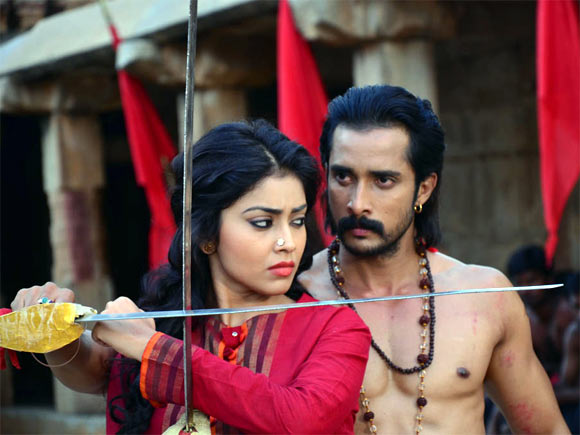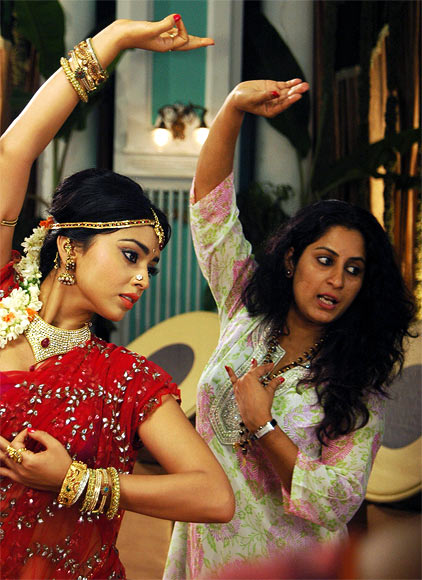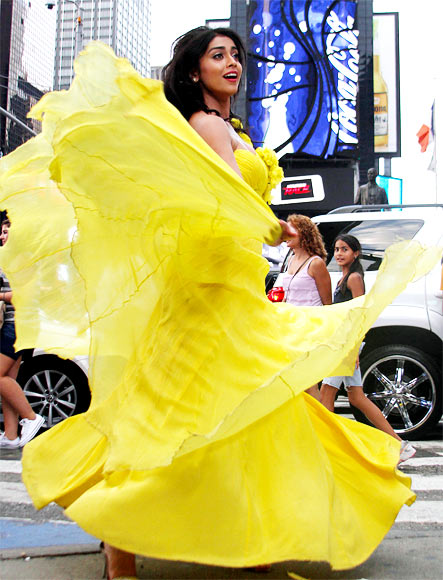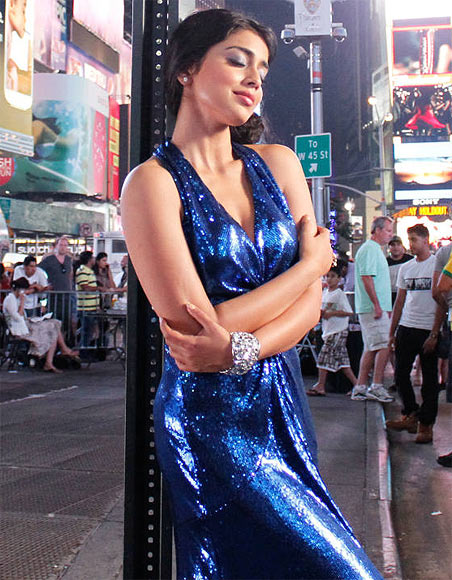 | « Back to article | Print this article |
'Shriya has brought her character to life in Chandra
Dancer, model, actor and activist Roopa Iyer's critically acclaimed film Mukhaputa on children affected by HIV/AIDS won awards at international and state levels.
Her Kannada feature film Chandra released recently, which she had produced, directed, choreographed and written lyrics for.
The film starring Shriya Saran, Prem Kumar and Ganesh Venkatraman, is the love story of a princess.
Aesthetically shot and visually rich, Chandra has been a critical and commercial success.
In this conversation post-release, Roopa Iyer talks to Radhika Rajamani about the film's making, among other things.
Chandra has got good reviews. Are you happy with the response the film has got?
I’m extremely happy.
Chandra caters to all generations. In fact, many retired people are coming to the theatres to watch it. The music and songs have been well received.
'I like straightforward stories'
The film seems to be inspired from royal lives with a love story woven in. How did you get the idea to make such a film?
I had met some royal families who had love marriages. Some of them ended on a sour note.
Love is in everyone’s lives. It is straight from the heart. The storyline is very simple as I like straightforward stories.
What kind of research did you do?
I read books and met royal families from Rajasthan, the Nizams, Mysore, Travancore and some in Tamil Nadu.
Some of them I met accidentally. I was inspired to make this film after talking to them.
'It took me more than six months to write the script'
Why did you want to make a film like this?
I was curios to know what the royal families are doing after the government has taken over their assets. How has life been for them. The princess can’t be like a normal person or like a princess. They are stuck in between.
There are obstacles too when they fall in love.
How long did the scriptwriting take?
It took me more than six months to write the script.
Did you weave in a love story to make it entertaining?
Yes. Vivek was chosen as the elder brother. I wanted to have comedy and action too, to make the love story lively. We shot the introductory fight scene in Haridwar and added Kalaripayattu in the film.
'Shriya is glamorous with a very feminine aura about her'
Why did you want to make it bilingual (Kannada-Tamil)?
I made it bilingual because I am a Tamilian based in Bengaluru with a passion for both Tamil and Kannada films.
It was a big story and I was investing lots of money. We shot it in the palace and spent Rs 4.50 lakh every day. Costumes too cost so much. So I felt it should be made as a bilingual.
What determined your choice of casting Shriya, Prem Kumar and Ganesh Venkatraman?
I wanted someone beautiful with good body language and an expressive face.
She had to be a good dancer, who looks good in Western and classical outfits -- essentially a glamorous heroine.
I met Diya Mirza, Amrita Rao, Divya Spandana, but nothing worked out. I wanted a famous personality for the role.
I was lucky to get Shriya and she has brought the character to life. Shriya is glamorous with a very feminine aura about her. She learnt Kalaripayattu for the film.
For the male character, I wanted someone mature who exuded masculinity and Prem Kumar fit the role -- he is six feet tall too. Ganesh Venkatraman is fair and tall and he plays an NRI guy from a royal family.
'Men don't like a woman to raise her voice'
Did Shriya agree to sign the film immediately?
I am extremely happy and lucky that she agreed immediately. She is a dedicated actress.
After the shoot, she would go to learn Kalari. She would personally check her costumes and hairstyle. She gave hundred per cent to the character.
She took two days to read up on me. I had done a film on a humanitarian issue and that proved to be a clincher for her.
How challenging was it to be the costume designer, producer and director, being a woman?
I wrote two songs and also did the choreography for three songs. I had to handle 120 people on a set.
Men don’t like a woman to raise her voice. I had to control big artistes and others. It was difficult. I worked on this film passionately as it was my dream project.
The film is visually rich...
The film is more like a romantic poem. I am thankful to director of photography Das who helped make my dream come true.
'I believe in my own creative energy'
To make this kind of film today is an arduous task and a risky proposition. How did you cope with it?
I believe in my own creative energy and giving my hundred per cent to any project.
Being a dancer, I think of creative things. I love to make passionate films in a qualitative and colourful way. The permissions to shoot in the palace and in Times Square in New York took a long time.
We waited for six months and then began the shoot. These were logistical problems but where there is a problem, there is a solution too.
Will you release the film in other languages besides Tamil?
After releasing in Tamil shortly, we are looking at dubbing it in Telugu and Malayalam.
You have been a model, dancer, actor and activist. What made you turn to filmmaking and do Mukhaputa, the film on children affected by HIV/AIDS?
It’s because of these special children who are suffering so much. I wanted to bring their suffering to the screen. No one had made a film on this issue. The film got many national and state awards.
Will you be making more films on social issues?
That’s my real life. We have a social responsibility. My profit goes to charity. Nobody carries anything with them when they die.
I work for children. I have a trust called Namma Mane which is into the health of HIV positive children and education of orphans and the destitute.





